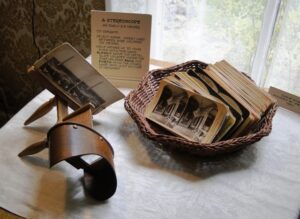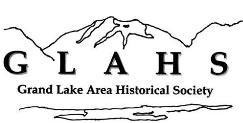-

Stereoscope and cards
- The Kauffman House museum has a collection of cards available for viewing in the dining room.
Click here to view our collection.- A stereoscope is a device for viewing a stereoscopic pair of separate images depicting left-eye and right-eye views of the same scene as a single three dimensional image.
Stereoscopic cards were popular from around the 1850s until early in the 20th century. They consisted of two photographs, each about three inches square, mounted on a board about 7 inches by 3.5 inches. They were viewed through a stereoscope to give a 3-D image.
In 1861 Oliver Wendell Holmes created and deliberately did not patent a handheld, streamlined, much more economical viewer than had been available before. The stereoscope, which dates from the 1850s consisted of two prismatic lenses and a wooden stand to hold the stereo card. This type of stereoscope remained in production for a century. It is primarily American.
The stereoscope was a form of entertainment as well as education. People ordered sets of cards showing nature, important government buildings, foreign places, palaces and popular entertainers. Some cards are humorous and others are families and familiar places. They had no television or internet and the stereoscope was passed around on a Sunday afternoon for visitors to enjoy.
Many of the cards were produced by the Kilburn Brothers from Littleton, New Hampshire. Edward and Benjamin West Kilburn began their careers as a supplier of views of the White Mountains and New Hampshire scenery in the 1860s. The brothers quickly expanded and by 1869 had a large plant and many titles for sale. When Edward retired, Benjamin took over full operations including all photography. James M. Davis became associated with B. W. Kiliburn in the early 1880s and was in charge of distribution. He also acted as a photographer. The Kilburn Company never issued boxed sets. When it ceased operations in 1909 the company had produced 17,000 views. The Kilburn Brothers were known as the world’s most extensive manufacturer of stereoscopic views from 1890 – 1910.
Strohmeyer & Wyman was another publisher of cards in the Grand Lake Area Historical Society Collection. Henry Strohmyer started out as photographer and co-owner of the stereoview publishing house Strohmeyer & Wyman. He took most of the pictures and maintained editorial control of both the content and the captions. They did all of their own publishing but hook up with another 3-D company Underwood and Underwood to exclusively handle the distribution of their products. In 1901 the Underwood Brothers, Bert and Elmer, bought out Strohmeyer & Wyman’s publishing operations and made Henry Strohmeyer Vice President of Underwood operations.
Underwood & Underwood, publishers, New York, London, Toronto, Canada, Ottawa, Kansas produced many sets of stereo cards around 1900. Their views were high quality photographs, often including figures or crowds amongst the city scenes. Underwood & Underwood were active, producing stereo views from 1882 until 1920, later continuing as a news service. At one time, they were the largest publisher of stereo views in the world, producing 10 million stereo views and 300,000 viewers in 1900. They purchased the printing works of Strohmeyer & Wyman but were themselves taken over by Keystone View Company who acquired the stock of Underwood & Underwood negatives.
